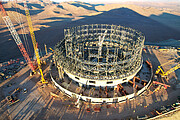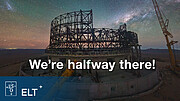Komunikat prasowy
Ekstremalnie Wielki Teleskop (ELT) jest w połowie gotowy
11 lipca 2023
Ekstremalnie Wielki Teleskop (ELT), budowany przez Europejskie Obserwatorium Południowe, to rewolucyjny teleskop naziemny, który będzie mieć 39-metrowe zwierciadło główne i stanie się największym teleskopem na świecie w zakresie widzialnym i podczerwonym: największym okiem świata na niebo. Budowa tego skomplikowanego technicznie przedsięwzięcia postępuje w dobrym tempie. Aktualnie ELT przekroczył 50% zaawansowania budowy.
Teleskop znajduje się na szczycie Cerro Armazones na chilijskiej pustyni Atakama, gdzie inżynierowie i pracownicy budowlani w zawrotnym tempie montują obecnie strukturę kopuły teleskopu. Stalowa struktura zmienia się z każdym dniem w widoczny sposób i wkrótce przybierze znajomy okrągły kształt, typowy dla kopuł teleskopów.
Zwierciadła teleskopy i inne jego elementy są budowane przez firmy w Europie, gdzie prace również postępują dobrze. ELT będzie mieć pionierski pięciozwierciadlany projekt optyczny, który obejmuje gigantyczne lustro główna (M1) złożone z 798 sześciokątnych segmentów. Jak dotąd wyprodukowano ponad 50% półfabrykatów i podpór dla tych segmentów, natomiast M2 i M3 są odlane i znajdują się w procesie szlifowania. W przypadku M4, adaptacyjnego, elastycznego zwierciadła, które będzie dostosowywać swój kształt tysiące razy na sekundę, aby korygować zaburzenia spowodowane turbulencjami powietrza, postęp jest szczególnie imponujący: wszystkie jego sześć cienkich płatów jest w pełni ukończonych i są obecnie integrowane ze strukturą. Co więcej, wszystkie sześć źródeł laserowych, które są kolejnym kluczowym komponentem systemu optyki adaptacyjnej ELT, zostało wyprodukowanych i dostarczonych do ESO do testowania.
Wszystkie pozostałe systemy potrzebne do skompletowania ELT, w tym system sterowania i wyposażenie niezbędne do złożenia i przetestowania teleskopu, także są w znacznym zaawansowaniu projektowania albo w produkcji. Co więcej, wszystkie cztery pierwsze instrumenty naukowe, w które ELT będzie wyposażony, znajdują się w końcowej fazie projektowania, a niektóre z nich przechodzą do fazy produkcji. Na dodatek, większość infrastruktury wspierającej dla ELT jest już na miejscu, na lub w pobliżu Cerro Armazones. Na przykład, budynki techniczne, które oprócz innych funkcji będą wykorzystywane do przechowywania i napylania warstw poszczególnych zwierciadeł ELT, są już w pełni zbudowane i wyposażone, a elektrownia fotowoltaiczna dostarczająca energię odnawialną dla infrastruktury ELT zaczęła działać w ubiegłym roku.
Budowa ELT zaczęła się dziewięć lat temu specjalnym wydarzeniem. Wierzchołek Cerro Armazones został wypłaszczony w 2014 roku, aby uzyskać przestrzeń dla ogromnego teleskopu.
Ocenia się, że ukończenie pozostałych 50% projektu będzie znacznie szybsze niż budowanie pierwszej połowy ELT. Pierwsza połowa projektu obejmowała długi i skrupulatny proces finalizowania projektu znacznej większości komponentów, które zostaną wyprodukowane dla ELT. Co więcej, niektóre z elementów, takie jak segment zwierciadła i wspierające je elementy i czujniki, wymagały dokładnego prototypowania i intensywnego testowania zanim zaczęły byś masowo produkowane. Na dodatek pandemia COIVD-19 wpłynęła na budowę, gdyż miejsce było zamknięte na kilka miesięcy i produkcja wielu komponentów teleskopu odnotowała opóźnienia. Obecnie procesy produkcyjne są w pełni przywrócone i usprawnione. Przewiduje się, że dokończenie pozostałej polowy ELT zajmie jedynie pięć lat. Niemniej jednak budowanie tak dużego i skomplikowanego teleskopu, jak ELT, nie jest wolne od ryzyka, dopóki nie zostanie ukończone i teleskop nie zacznie działać.
Dyrektor Generalny ESO, Xavier Barcons, mówi: „ELT jest największym naziemnym teleskopem optycznym i bliskiej podczerwieni następnej generacji. Również jego budowa jest najbardziej zaawansowana. Osiągnięcie 50% ukończenia to nie lada wyczyn, biorąc pod uwagę wyzwania nieodłącznie związane z wielkimi, złożonymi projektami. Było to możliwe tylko dzięki zaangażowaniu wszystkich w ESO, nieustannemu wsparciu Krajów Członkowskich ESO oraz zaangażowaniu naszych partnerów w przemyśle i konsorcjach instrumentów. Jestem niezwykle dumny, że ELT osiągnął ten kamień milowy.
ELT, który według planów ma ma zacząć obserwacje naukowe w 2028 roku, zajmie się takimi pytaniami w astronomii, jak: Czy jest jesteśmy samo we Wszechświecie? Czy prawa fizyki są uniwersalne? Jak powstały pierwsze gwiazdy i galaktyki? Radykalnie zmieni to, co wiemy o naszym Wszechświecie i zmusi do ponownego przemyślenia naszego miejsca w kosmosie.
Uwagi
Procent ukończenia ELT oszacowano na podstawie „wartości wypracowanej”, metryki stosowanej w zarządzania projektami do oceny postępów w projekcie, która bierze pod uwagę harmonogram i koszty. Aktualnie ELT realizuje plan projektu w 50%.
Więcej informacji
Europejskie Obserwatorium Południowe (ESO) umożliwia naukowcom z całego świata na odkrywanie tajemnic Wszechświata z korzyścią dla nas wszystkich. Projektujemy, budujemy i zarządzamy światowej klasy obserwatoriami naziemnymi – których astronomowie używają do odpowiadania na ciekawe pytania i szerzenia fascynacji astronomią – a także promujemy międzynarodową współpracę w astronomii. Ustanowione w 1962 roku jako organizacja międzynarodowa, ESO jest wspierane przez 16 krajów członkowskich (Austria, Belgia, Czechy, Dania, Finlandia, Francja, Hiszpania, Irlandia, Holandia, Niemcy, Polska, Portugalia, Szwajcaria, Szwecja, Wielka Brytania oraz Włochy), a także Chile jako kraj gospodarz, oraz Australię jako strategicznego partnera. Siedziba ESO, a także jego centrum popularyzacji nauki i planetarium (ESO Supernova) znajdują się w pobliżu Monachium w Niemczech, natomiast chilijska pustynia Atakama – niesamowite miejsce z wyjątkowymi warunkami do obserwacji nieba – jest domem dla naszych teleskopów. ESO zarządza trzema lokalizacjami obserwacyjnymi w Chile: La Silla, Paranal i Chajnantor. W Paranal ESO posiada teleskop VLT (Very Large Telescope – Bardzo Duży Teleskop) oraz dwa teleskopy do przeglądów nieba. VISTA pracuje w podczerwieni, VLT Survey Telescope w zakresie widzialnym. W Paranal ESO zarządza także południowym obserwatorium CTA (Cherenkov Telescope Array South) – największym na świecie i najbardziej czułym obserwatorium promieniowania gamma. Wspólnie z międzynarodowymi partnerami ESO zarządza także radioteleskopami APEX i ALMA, które są instrumentami do obserwacji nieba w zakresach milimetrowym i submilimetrowym. Na Cerro Armazones, niedaleko Paranal, budujemy „największe oko świata na niebo”, czyli Ekstremalnie Wielki Teleskop (Extremely Large Telescope, ELT). Nasza działalność w Chile jest zarządzania z biur ESO w Santiago, gdzie współpracujemy też z chilijskimi partnerami.
Linki
Kontakt
Bárbara Ferreira
ESO Media Manager
Garching bei München, Germany
Tel.: +49 89 3200 6670
Tel. kom.: +49 151 241 664 00
E-mail: press@eso.org
Krzysztof Czart (Kontakt dla mediów Polska)
Sieć Popularyzacji Nauki ESO
oraz Urania - Postępy Astronomii
Toruń, Polska
Tel.: +48 513 733 282
E-mail: eson-poland@eso.org
O komunikacie
| Komunikat nr: | eso2310pl |
| Nazwa: | Extremely Large Telescope |
| Typ: | Unspecified : Technology : Observatory |
| Facility: | Extremely Large Telescope |
Our use of Cookies
We use cookies that are essential for accessing our websites and using our services. We also use cookies to analyse, measure and improve our websites’ performance, to enable content sharing via social media and to display media content hosted on third-party platforms.
ESO Cookies Policy
The European Organisation for Astronomical Research in the Southern Hemisphere (ESO) is the pre-eminent intergovernmental science and technology organisation in astronomy. It carries out an ambitious programme focused on the design, construction and operation of powerful ground-based observing facilities for astronomy.
This Cookies Policy is intended to provide clarity by outlining the cookies used on the ESO public websites, their functions, the options you have for controlling them, and the ways you can contact us for additional details.
What are cookies?
Cookies are small pieces of data stored on your device by websites you visit. They serve various purposes, such as remembering login credentials and preferences and enhance your browsing experience.
Categories of cookies we use
Essential cookies (always active): These cookies are strictly necessary for the proper functioning of our website. Without these cookies, the website cannot operate correctly, and certain services, such as logging in or accessing secure areas, may not be available; because they are essential for the website’s operation, they cannot be disabled.
Functional Cookies: These cookies enhance your browsing experience by enabling additional features and personalization, such as remembering your preferences and settings. While not strictly necessary for the website to function, they improve usability and convenience; these cookies are only placed if you provide your consent.
Analytics cookies: These cookies collect information about how visitors interact with our website, such as which pages are visited most often and how users navigate the site. This data helps us improve website performance, optimize content, and enhance the user experience; these cookies are only placed if you provide your consent. We use the following analytics cookies.
Matomo Cookies:
This website uses Matomo (formerly Piwik), an open source software which enables the statistical analysis of website visits. Matomo uses cookies (text files) which are saved on your computer and which allow us to analyze how you use our website. The website user information generated by the cookies will only be saved on the servers of our IT Department. We use this information to analyze www.eso.org visits and to prepare reports on website activities. These data will not be disclosed to third parties.
On behalf of ESO, Matomo will use this information for the purpose of evaluating your use of the website, compiling reports on website activity and providing other services relating to website activity and internet usage.
Matomo cookies settings:
Additional Third-party cookies on ESO websites: some of our pages display content from external providers, e.g. YouTube.
Such third-party services are outside of ESO control and may, at any time, change their terms of service, use of cookies, etc.
YouTube: Some videos on the ESO website are embedded from ESO’s official YouTube channel. We have enabled YouTube’s privacy-enhanced mode, meaning that no cookies are set unless the user actively clicks on the video to play it. Additionally, in this mode, YouTube does not store any personally identifiable cookie data for embedded video playbacks. For more details, please refer to YouTube’s embedding videos information page.
Cookies can also be classified based on the following elements.
Regarding the domain, there are:
- First-party cookies, set by the website you are currently visiting. They are stored by the same domain that you are browsing and are used to enhance your experience on that site;
- Third-party cookies, set by a domain other than the one you are currently visiting.
As for their duration, cookies can be:
- Browser-session cookies, which are deleted when the user closes the browser;
- Stored cookies, which stay on the user's device for a predetermined period of time.
How to manage cookies
Cookie settings: You can modify your cookie choices for the ESO webpages at any time by clicking on the link Cookie settings at the bottom of any page.
In your browser: If you wish to delete cookies or instruct your browser to delete or block cookies by default, please visit the help pages of your browser:
Please be aware that if you delete or decline cookies, certain functionalities of our website may be not be available and your browsing experience may be affected.
You can set most browsers to prevent any cookies being placed on your device, but you may then have to manually adjust some preferences every time you visit a site/page. And some services and functionalities may not work properly at all (e.g. profile logging-in, shop check out).
Updates to the ESO Cookies Policy
The ESO Cookies Policy may be subject to future updates, which will be made available on this page.
Additional information
For any queries related to cookies, please contact: pdprATesoDOTorg.
As ESO public webpages are managed by our Department of Communication, your questions will be dealt with the support of the said Department.




